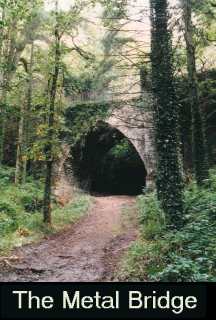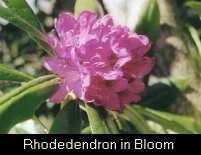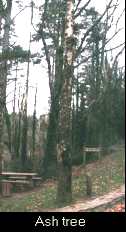








| ||
|
Stop 16
Here is a young Elm tree. It is the only one I have ever seen in Glenbower.
It has so far escaped the ravages of Dutch Elm's disease which was identified by scientists in Holland in 1917 and spread quickly wiping out many European Elms. New Strains appeared in England in the 1960's causing further devastation of the Elm population.
|
 |
|
 Stop 17
This bridge,called the Metal Bridge, and the
original White Bridge
further upstream were the beginnings of the planned improvements to
access on the estate by the landlord de Cappell Brooke in the early 1830s.
There is elaborate workmanship in stone and iron on the bridge parapet.
There are spectacular Rhododendron here,
Stop 17
This bridge,called the Metal Bridge, and the
original White Bridge
further upstream were the beginnings of the planned improvements to
access on the estate by the landlord de Cappell Brooke in the early 1830s.
There is elaborate workmanship in stone and iron on the bridge parapet.
There are spectacular Rhododendron here,
 the roots are at ground level and
the blooms appear just at the top of the bridge and just out of reach.
Although beautiful, Rhododendron tends to
take over a woodland if it is not controlled.
the roots are at ground level and
the blooms appear just at the top of the bridge and just out of reach.
Although beautiful, Rhododendron tends to
take over a woodland if it is not controlled.
| ||
 Stop 18
The trees at the final stop are Ash. The Ash also has
a compound leaf.The seeds which are produced in autumn have wings which aid
their dispersal.In winter it can be identified by it's smooth bark and
black buds.Hurley sticks are traditionally cut from the butt end of the Ash.
This is in order to provide a curving grain on the hurley "bos". Ash is also
used in many other ways for sports goods where lightness coupled with
elasticity and strength are required.
Stop 18
The trees at the final stop are Ash. The Ash also has
a compound leaf.The seeds which are produced in autumn have wings which aid
their dispersal.In winter it can be identified by it's smooth bark and
black buds.Hurley sticks are traditionally cut from the butt end of the Ash.
This is in order to provide a curving grain on the hurley "bos". Ash is also
used in many other ways for sports goods where lightness coupled with
elasticity and strength are required.
|
||
|
That's the end of the trail,why don't you visit the
Gallery? These pages may take some time to download.
| ||
| HOME| PREVIOUS| START THE TRAIL| STOPS 1-3| STOPS 4-6| STOPS 7-9| STOPS 10-12| STOPS 13-15| GALLERY 1| GALLERY 2| GALLERY 3| GALLERY 4| BRIEF HISTORY| | ||
Website designed and maintained by Orla Irwin.